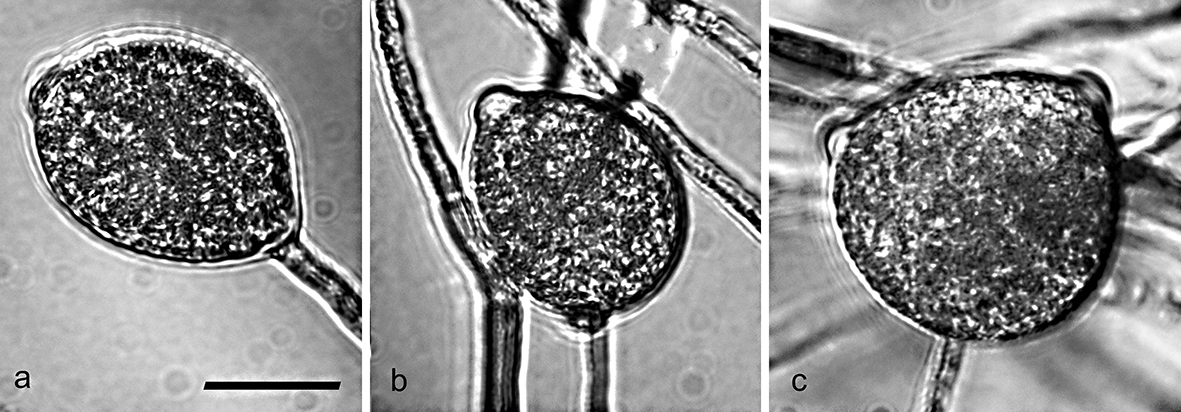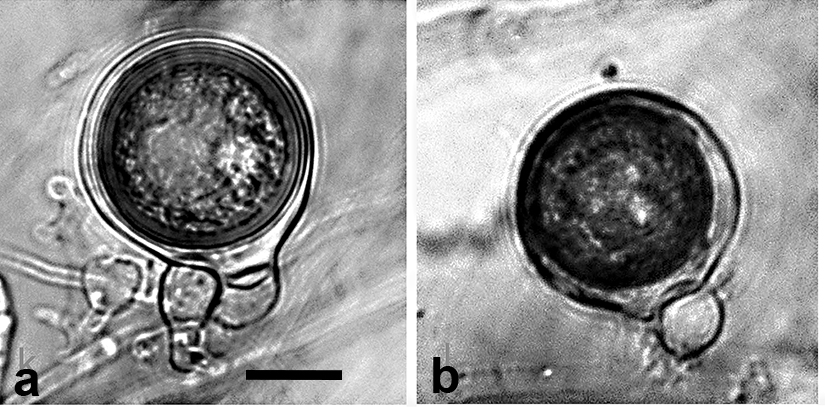Phytophthora alticola
|
Phytophthora spp. in Clade 4: portion of the seven-loci ML phylogeny featuring the type cultures of 212 described species (by T. Bourret). Notice the position of P. alticola Ex-neotype CBS 141718. Gloria Abad, USDA S&T.
|
|
Phytophthora spp. in Clade 4: Morphological Tabular key (PDF) and Tabular key legends (PDF) in IDphy2 KEY SECTION. Notice the data of P. alticola Ex-type CBS 141718. Gloria Abad, USDA S&T.
|
|
colony morphology after 7 days growth at 20ºC on CA, V8A, ½ PDA, and MEA (left to right) |
|
ovoid papillate and bipapillate sporangia, scale bar = 20 µm |
|
oogonia with wavy margins and aplerotic oospores with paragynous antheridia, scale bar = 20 µm |
Name and publication
Phytophthora alticola Maseko, Coutinho & Wingfield (2007)
Maseko B, Burgess TI, Coutinho TA; Wingfield MJ. 2007. Two new Phytophthora species from South Africa. Mycol. Res. 111: 1321–1338.
Phytophthora alticola Maseko, Cout. & M.J. Wingf. (2007) emend Bose et al. 2017
Bose T, Burgess TI, Roux J, Wingfield MJ. 2017. Phytophthora alticola; revised description based on new collections and a neotype. Sydowia. 69: 161–170.
Corresponding author: tanaybose15@gmail.com
Nomenclature
from Bose et al. (2017)
Mycobank
Typification
amended description (Bose et al. 2017)
Neotype: SOUTH AFRICA, KwaZulu-Natal, Commondale, from Eucalyptus grandis, November 2014, leg. T. Bose PREM61767
Ex-neotype: CBS 141718 = CMW48711
Sequences of ex-neotype in amended manuscript: Phytophthora alticola isolate TBF0060A10 = ITSrDNA KX247599, B-tub KX247592, HSP90 KX247578, CoxI KX247585
Ex-type in other collections
(ENT) CBS 141718, CMW48711, TBF0060A10
Molecular identification
Voucher sequences for barcoding genes (ITS rDNA and COI) of the ex-type (see Molecular protocols page)
Phytophthora alticola isolate TBF0060A10 ITS rDNA KX247599
Voucher sequences for Molecular Toolbox with seven genes (ITS, β-tub, COI, EF1α, HSP90, L10, and YPT1
(see Molecular protocols page) (In Progress)
Voucher sequences for Metabarcoding High-throughput Sequencing (HTS) Technologies [Molecular Operational Taxonomic Unit (MOTU)]
(see Molecular protocols page) (In Progress)
Sequences with multiple genes for ex-type in other sources
- NCBI: Phytophthora alticola TBF0060A10
- EPPO-Q-bank: Phytophthora alticola
- BOLDSYSTEMS: Phytophthora alticola
Position in multigenic phylogeny with 7 genes (ITS, β-tub, COI, EF1α, HSP90, L10, and YPT1)
Clade clade:
a taxonomic group of organisms classified together on the basis of homologous features traced to a common ancestor
4
Morphological identification
Colonies and cardinal temperatures
Colony colony:
assemblage of hyphae which usually develops form a single source and grows in a coordinated way
morphology is appressed with no distinctive growth pattern and regular smooth margins on CA, V8A, MEA, and PDA. Minimum growth temperature 10°C, optimum 25°C, and maximum 32.5°C.
Conditions for growth and sporulation
SporangiaSporangia:
sac within which zoospores form, especially when water is cooled to about 10°C below ambient temperature; in solid substrates, sporangia usually germinate by germ tubes
are produced in water cultures (soil extract or river water) and not observed in solid media. OogoniaOogonia:
the female gametangium in which the oospore forms after fertilization by the antheridium
are formed readily in single-strain culture on CA and V8A after about 14 days.
Asexual phase
SporangiaSporangia:
sac within which zoospores form, especially when water is cooled to about 10°C below ambient temperature; in solid substrates, sporangia usually germinate by germ tubes
are papillatepapillate:
pertaining to the production of a distinct papilla at the distal end of the sporangium (cf. nonpapillate and semipapillate)
, persistentpersistent:
pertaining to sporangia that remain attached to the sporangiophore and do not separate or detach easily (cf. caducous)
, and predominantly ovoidovoid:
egg-shaped, with the widest part at the base of the sporangium and the narrow part at the apex
. SporangiaSporangia:
sac within which zoospores form, especially when water is cooled to about 10°C below ambient temperature; in solid substrates, sporangia usually germinate by germ tubes
average 37.9 ± 4.1 × 27.2 ± 4.5 mm (overall range 19.6–49.2 × 17.4–36.7 mm). Sporangiophores in simple sympodiasympodia:
a type of sporangiophore which appears simple, but where each successive sporangium develops on a branch behind and to one side of the previous apex, where growth has already ceased
with no proliferationproliferation:
formation of a sporangium within an empty sporangium that has previously emitted zoospores (internal or nested) or after the sporangiophore has emerged from the empty sporangium (external)
. Hyphal swellings are rare. ChlamydosporesChlamydospores:
an asexual spore with a thickened inner wall that is delimited from the mycelium by a septum; may be terminal or intercalary, and survives for long periods in soil
absent
Sexual phase
Homothallic. OogoniaOogonia:
the female gametangium in which the oospore forms after fertilization by the antheridium
are globoseglobose:
having a rounded form resembling that of a sphere
with wavy walls turning golden-brown on maturity, average size 28 ± 2.5 mm (20.4–32.3 mm). OosporesOospores:
zygote or thick-walled spore that forms within the oogonium after fertilization by the antheridium; may be long-lived
are apleroticaplerotic:
pertaining to a mature oospore that does not fill the oogonium; i.e. there is room left between the oospore wall and oogonium wall (cf. plerotic)
, globoseglobose:
having a rounded form resembling that of a sphere
with thick walls, average size 23.03 ± 2.47 µm (19.1−29.2). AntheridiaAntheridia:
the male gametangium; a multinucleate, swollen hyphal tip affixed firmly to the wall of the female gametangium (the oogonium)
are paragynousparagynous:
pertaining to the sexual stage in which the antheridium is attached to the side of the oogonium (cf. amphigynous)
.
Most typical characters
Phytopthora alticola forms a species complex with Phytophthora boodjera and Phytophthora arenaria and is morphologically very similar to these species.
Specimen(s) evaluated
South Africa; KwaZulu-Natal, Commondale, from Eucalyptus grandis soil sample, Nov. 2014, T. Bose, CBS141718 = CMW48711; Melmoth, from natural forest soil sample, Nov. 2015, T Bose, CBS141719= CMW48712; Melmoth, from natural forest soil sample, Nov. 2015, Tanay Bose, CBS141720 = CMW48713; Melmoth, from E. grandis soil sample, Mar. 2016, T Bose, CBS141721 = CMW48714; Melmoth, from E. grandis soil sample, Mar. 2016, Tanay Bose, CBS141722 = CMW48715. Commondale, from A. mearnsii soil sample (S14.527 E31 00.144), Mar. 2016, Tanay Bose, CBS141723 = CMW48716. Vryheid, from E. grandis soil sample, Mar. 2016, collected by Tanay Bose, CBS141724 = CMW48717.
Hosts and distribution
Notes: A nom. dub. per Simamora et al. (2015)
Distribution: Africa (South Africa)
Substrate: plant material, soil
Disease note: Eucalyptus collar and root rot
Host: Eucalyptus badjensis, Eucalyptus dunnii, Eucalyptus macarthurii (Myrtaceae)
Retrieved February 01, 2018 from U.S. National Fungus Collections Nomenclature Database.
Additional references and links
- SMML USDA-ARS: Phytophthora alticola
- EPPO Global Database: Phytophthora alticola
- Forest Phytophthoras of the World: Phytophthora alticola
- CABI Digital Library: Phytophthora alticola
- Encyclopedia of Life (EOL): Phytophthora alticola
- Index Fungorum (IF): Phytophthora alticola
- Google All Phytophthora alticola
- Google Images Phytophthora alticola
- Google Scholar Phytophthora alticola
Fact sheet authors
Treena Burgess, Ph.D., Phytophthora Science and Management, Harry Butler Institute, Murdoch University, Australia
Z. Gloria Abad, Ph.D., USDA-APHIS-PPQ-S&T Plant Pathogen Confirmatory Diagnostics Laboratory (PPCDL), United States of America.




